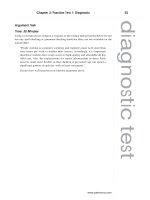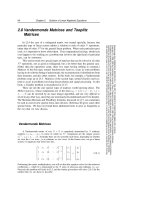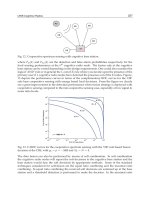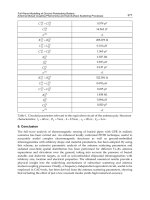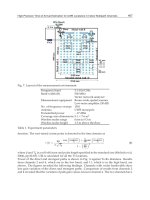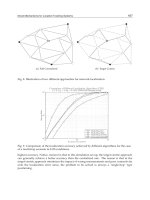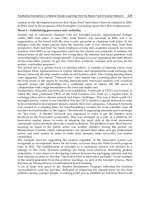BIOMES OF THE EARTH - GRASSLANDS Part 9 docx
Bạn đang xem bản rút gọn của tài liệu. Xem và tải ngay bản đầy đủ của tài liệu tại đây (742.49 KB, 29 trang )
evaporation pan that is left standing in the open. Obviously
the amount of water lost from the ground by evaporation
cannot exceed the amount that falls as precipitation, but the
potential evaporation can exceed the precipitation. It is pos-
sible, therefore, for precipitation to increase but for the
ground to become drier
.
If the average temperature rises by less than about 3.6°F
(2°C), precipitation will increase more than the potential
evaporation and so the ground will become more moist. This
might allow some plant species to grow more vigorously at
the expense of others, altering the balance of species in the
natural grassland community, and it might encourage the
growth of more trees. Where grassland has been converted to
arable farmland, soil that is moister might increase crop
yields, although crops could be damaged if some of the
increased precipitation arrives in the form of violent hail-
storms.
If the average temperature rises by more than about 3.6°F
(2°C), potential evaporation will increase faster than precipi-
tation and the ground will become drier. This would be a
more serious situation. Crops would need more irrigation to
make good the shortfall, and in time natural grassland would
become dominated by plants that tolerate drought while less
tolerant plants would disappear.
At present the evidence suggests that the rise in tempera-
ture will be modest and grasslands will not suffer, although
their composition may change. It is possible that forest
might expand into moister areas of what is now grassland. If
the rate of warming were to increase substantially, however,
grasslands would be confined to the moister regions while
other areas turned to semidesert or desert.
Expansion of towns and roads
Nowadays most Americans and Europeans live in cities. In
the United States 79 percent of the population lives in urban
areas. In the United Kingdom 89.5 percent of people are city
dwellers, in France the proportion is 75.5 percent, and in
Germany it is 87.7 percent. More Italians live in the country-
side, but even in Italy 67.1 percent of the population is
214 GRASSLANDS
THREATS TO GRASSLAND 215
urban. Russia is vast, but 73.3 percent of Russians live in
cities.
The move into the cities is fairly recent. Many city dwellers
were born and raised in rural areas, and even more of them
have parents or grandparents who lived in the countryside.
Urban expansion is a process that accompanies the industri-
alization of economies. Britain is one of the most highly
urbanized countries in the world, but in about 1800 almost
75 percent of the population lived in villages and hamlets,
and most of the towns outside London had fewer than 1,000
inhabitants. In 1851 approximately 25.5 percent of the pop-
ulation lived in urban areas, but by 1931, only 80 years later,
this proportion had risen to 76.7 percent. Industrialization
and the associated urbanization occurred earlier in Britain
than in most other countries, but even there many people
still feel they have family links to the countryside. In other
parts of the world the links are closer.
People moved into the cities—and still do—in search of a
better life. Employment opportunities were greater and
wages were higher than those paid by farmers. Despite the
overcrowding, poor sanitation, and appalling working condi-
tions in the industrializing cities of the 19th and early 20th
centuries, urban life promised better prospects of improved
living standards. They offered hope—dreams of streets paved
with gold. But as the unrealized dreams faded, the new city
dwellers began to recall their former rural lives more fondly.
Memories of clear blue skies, green fields, trees, rivers of clean
water, and sweet-smelling air seemed very attractive amid the
smoke and grime of the city streets. The long hours of hard
labor in the cold, rain, and mud were forgotten, along with
the hunger, grinding poverty, and insecurity that were the lot
of most farmworkers.
As a consequence, many modern city dwellers value the
countryside highly. Some dream of moving there to live, and
others content themselves with occasional visits, but even
people who never leave the city find reassurance in the
knowledge that the countryside exists and that they could
visit it if an opportunity arose and they chose to do so. Many
do visit the countryside, of course. When the railroads
opened in the course of the 19th century one of their first
tasks was to run excursions from the cities into the country-
side, and the number of visitors increased still more rapidly
when affordable mass-produced automobiles became avail-
able.
The countryside has come to be valued both as an amenity
and as the historic background to the lives of our own fami-
lies. Not surprisingly people guard it jealously and are strenu-
ous in their opposition to any development that would
diminish it.
People object to the expansion of urban areas into the
countryside, both because this reduces the area of country-
side and because expansion that takes place on the edge of an
existing city moves the countryside farther away from those
living near the urban center. Roads provide access to the
countryside, but to do so they remove ribbons of country-
side. They are also visually intrusive and noisy, and vehicle
exhausts from them pollute the air.
Each year in the United States 1 million new homes and
approximately 10,000 miles (16,000 km) of new roads are
built in the 48 contiguous states and District of Columbia.
Buildings and roads now cover 43,480 square miles (112,610
km
2
). That is an area almost as large as the state of Ohio. It
sounds immense, and the rate of expansion sounds alarming
because of our high regard for the countryside across which
these homes and roads are spreading. How can anyone doubt
that urban expansion is gobbling up the countryside? Surely
the scale of the problem is clear. At this rate it cannot be long
before the few remaining patches of natural grassland vanish
beneath the asphalt and concrete.
Indeed the total urban area of the United States is large,
but many of the new houses are built to replace old houses
that have been demolished. Even if all of them were being
built in open countryside, however, the United States is a big
country and buildings and roads cover only a tiny proportion
of it—no more than 1.4 percent. This makes the United
States more highly urbanized than the world average, of 0.2
percent of the total land area, but less so than some coun-
tries. In Britain buildings and roads cover 3.9 percent of the
land.
216 GRASSLANDS
THREATS TO GRASSLAND 217
This is not the way it appears to people traveling out from
the cities. They see the road or rail track lined by buildings
that extend far from the city center, with other groups of
buildings in the distance, separated by fields and trees, giving
them the impression that countryside survives only in pock-
ets. It is not so, and the view from the air quickly dispels this
false impression. Very little of the countryside has been sacri-
ficed to urban development even in the most densely popu-
lated and highly urbanized countries, and there is no reason
to suppose the urban area will increase greatly in years to
come. Buildings and roads are unlikely to spread across the
world’s grasslands.
Lessons from the Dust Bowl
Grasslands grow in those parts of the world where the cli-
mate is too dry to sustain forests but not so dry as to prevent
all plant growth. In a climate of this type droughts are likely
to occur at intervals, and the fact that the grassland plants
survive shows they are adapted to periodic drought. The
Great Plains of North America are no exception, and the
drought that caused the Dust Bowl (see “The Dust Bowl” on
pages 55–57) was not unique. It led to tragedy—for the land
as well as for the families it ruined—because farmers had
been lulled into a false sense of security by several years of
good weather and because they failed to take measures that
would have reduced the amount of soil erosion.
Two lessons emerged from the Dust Bowl disaster. The first
was that the native prairie grasses were able to survive pro-
longed drought. The second was that soil erosion can be min-
imized and that farmers needed to be educated in the tech-
niques of soil conservation.
Grassland ecologists in Nebraska, Iowa, and Kansas studied
the effects of the drought as it developed. In the years prior
to the drought, vegetation covered 85 percent of the surface
on the short-grass prairie where no livestock grazed. As the
drought progressed, the grasses began to die back and new
growth failed to appear in the spring, until by 1940 plants
covered only 20 percent of the surface. The composition of
the grassland also changed. As some plants—other flowering
herbs (forbs) as well as grasses—died back, others spread.
Nevertheless, the ground was almost bare and its surface soil
blew in the wind.
When the drought ended with the return of the rain in the
winter of 1941–42, grasses and forbs that had not been seen
for several years began to emerge above ground. Their roots
MANAGING
THE GRASSLANDS
CHAPTER 11
218
MANAGING THE GRASSLANDS 219
or underground stems had survived in a dormant state, need-
ing only a generous soaking to stimulate them into produc-
ing new shoots. Moreover even while dormant, those roots
and underground stems (rhizomes) bound soil particles
together. Soil blew from the natural prairie and produced
dust storms, but much more soil blew from land where the
native grasses had been removed.
Soil scientists and ecologists recognized that certain parts
of the short-grass prairie should not be cultivated because of
the high risk of soil erosion during the inevitable periodic
droughts. These areas were left as natural prairie or sown
with native species where these had been removed.
The need to improve farming practices was obvious, and in
1935 the Soil Conservation Act established the Soil Con-
servation Service (SCS) as a bureau of the U.S. Department of
Agriculture (USDA). Hugh Hammond Bennett (1881–1960),
one of the world’s leading authorities on soil conservation,
was the first head of the SCS. The new service directed its
help and advice beyond the Great Plains to farmers through-
out the nation.
Under Bennett’s direction SCS advisers promoted soil con-
servation techniques that were traditional in Europe. Bernard
Eduard Fernow (1851–1923), a German immigrant who went
on to head the USDA Division of Forestry, had demonstrated
them at the Cotton States International Exposition held at
Atlanta, Georgia, in 1895. Fernow showed three large models
that had been made according to his instructions to show
the same farm under different conditions. The first model
showed the erosion that followed when deforested land was
farmed badly; the second showed the same land being
reclaimed; and the third showed the land fully recovered and
productive. Techniques to prevent soil erosion clearly exist-
ed, and Fernow published photographs of his models in the
1895 edition of the Year Book of the United States Department of
Agricultur
e (now called the Yearbook of Agriculture). Experts
also encouraged farmers to adopt dry farming methods (see
the sidebar “Dr
y farming” on page 224).
The SCS divides the country into “soil conservation dis-
tricts,” and in 1956 Congress designed the Great Plains
Conservation Program to help farmers and ranchers devise
and apply conservation measures to reduce the risk of ero-
sion on their own land. Under the program landowners
planted rows of trees and shrubs as windbreaks to shelter
land from the wind. The program also improved the efficien-
cy of irrigation systems and the reliability of water supplies to
livestock. Many of the ponds built to conserve water also
contain fish. Such measures as these have enhanced the
beauty of the countryside, while increasing the productivity
of the land.
The drought that drove countless families from their farms
generated dust clouds that filled the sky over vast areas, and
created the Dust Bowl was a catastrophe of epic proportions.
It demanded an effective response, and it received one.
Droughts continue to occur at intervals—they are natural
phenomena and inevitable—but even though they continue
to generate dust storms, the damage can now be limited.
Ranching on equatorial grasslands
Cattle ranching is widespread on land that was formerly
forested in tropical South America. Ranching accounts for an
estimated 44 percent of all the deforestation that occurs in
the whole of the South American tropical forest and for 70
percent of the deforestation in Brazil. Since the mid-1960s
approximately 58,000 square miles (150,000 km
2
) of
Amazonian forest has been converted to grassland, mainly in
southern Pará and northern Mato Grosso states.
The ranchers are descended from Spanish and Portuguese
settlers, and the first cattle ranch was established in 1692, on
Marajó Island, near Belém, Brazil. Far from being a recent
phenomenon, ranching is deeply rooted in Hispanic culture,
and there have been cattle ranches in the South American
Tropics for more than three centuries.
Nor is it true that the conversion of tropical forest to cattle
ranches is driven by the “hamburger connection”—the
demand for cheap beef in the United States. International
beef prices were high in the 1960s and early 1970s, and the
United States was an important export market for South
American beef during those years, but almost none of the
beef was raised on deforested land. In 1982 the Amazon sup-
220 GRASSLANDS
MANAGING THE GRASSLANDS 221
plied a mere 0.0007 percent of the beef consumed in the
United States, and the Amazon region never produced more
than five percent of Brazilian beef. The region has been a net
importer of beef in most years. Most Brazilian beef is
processed before export into such products as corned beef
and sausages. Beef prices fell during the 1980s, and the U.S.
market became more dependent on domestic production and
imports from other North American Free Trade Agreement
(NAFTA) members, with the result that U.S. beef imports
from the whole of Latin America have declined greatly since
then.
Ranching expanded for several reasons. Land prices rose
steadily for several decades in tropical Latin America, making
land acquisition a sound investment, and when governments
introduced settlement programs and designated particular
forest areas as reserves for conservation, prices rose even
faster. Buyers acquired their land from governments, and sev-
eral governments made it a condition of ownership that the
buyer occupy the land. This policy made deforestation a con-
dition of land ownership. Since it was easier and cheaper to
convert forest to ranch land than to plow it and grow crops,
ranching became the simplest way to meet the requirement.
Some governments paid subsidies for clearing forest and
introducing livestock. These incentives have now ended in
most countries.
Ranchers also raise dairy cattle. The smaller stock farms
generally specialize in dairying and the bigger ranches in beef
production.
Cleared forest was sown with pasture grasses and stocked
with about one head of cattle on every two acres (1.5/ha), but
after about five years there were some places where the pas-
ture would support no more than one animal to every six
acres (0.5/ha). Weeds had sprung up among the sown grass,
sprouts were growing from tree stumps, and trampling by
cattle had compacted the soil. Insect pests attacked the
grasses, termites thrived, and birds and mammals continued
to deposit weed seeds. Ranchers responded by sowing dif-
ferent grass species and experimenting with different stock-
ing densities. They found that if stocking is too sparse, the
weeds will proliferate, and if it is too dense, the pasture will
be overgrazed and the soil damaged by trampling—also en-
couraging weeds. Ranchers and farmers control weeds main-
ly by clearing them manually and by planting braquiarao,
also called brizantão (Brachiaria brizantha), a pasture grass
that grows vigorously and suppresses weeds. Herbicides are
too costly to be used extensively
.
Demand for beef and dairy products is rising, and pastures
must be improved if the demand is to be met with the least
harm to the environment. This will require more research
into the most suitable species of pasture grasses and the most
efficient management techniques. Increasing the productivi-
ty of existing farms and ranches will ease the pressure on the
forest. There will be less need to clear the forest to provide
more land, and landowners may find they have surplus land
on which they can grow crops. This process will not remove
the threat of deforestation, but it will reduce it.
Farming tropical grasslands
Tropical grasslands support large herds of grazing mammals
such as buffalo, antelope, elephants, and gazelles. The
Serengeti and Masai Mara are world famous for their herds of
grazers and for the lions, cheetahs, hyenas, and dogs that
pursue them (see “Protecting grassland species” on pages
201–204). Local people have hunted game animals through-
out history, and in Africa they also graze domestic livestock—
humped (zebu) cattle, sheep, and goats—on the savanna
grassland.
Savanna grasslands cover two-thirds of the land area of the
African continent, and although the wildlife is protected in
reserves such as the Serengeti and Masai Mara, grasslands
outside the reserves are under threat. The human population
is increasing, and some African countries encourage people
to settle on the grasslands to relieve pressure on the much
smaller areas of arable farmland. The people who live on the
grassland and graze their livestock there depend on their
domestic animals for food and income, and they rely on the
natural vegetation for plant foods, fuel, and raw materials for
building and for making household items such as furniture.
222 GRASSLANDS
MANAGING THE GRASSLANDS 223
The average annual rainfall is 12–28 inches (300–700 mm),
making the area too dry for conventional arable farming, and
most people of the African savanna lead a pastoral life.
Depending on local conditions, some live as nomads, mov-
ing their livestock from one seasonal pasture to the next.
Others live a more settled life, moving between winter and
summer pastures. There are also ranches on the savanna,
where the people have permanent homes and allow their cat-
tle to range over a wide area. Some people grow a few crops as
well as tending livestock. These ways of life are traditional,
but as pressure on the grasslands has intensified, overgrazing
has become a serious problem (see “Overgrazing and soil ero-
sion” on pages 209–211).
Savanna grasslands are so extensive and so many people
depend on them that ways must be found to manage them
more efficiently. At present grasslands are undervalued. The
fate of tropical forests is a matter of great international con-
cern, but grasslands are largely neglected. They belong to no
one and are therefore vulnerable to the “tragedy of the com-
mons.”
A development program in the Darwin-Kakadu region of
northern Australia is supporting farmers as they rapidly con-
vert the grasslands to farmland. At the time the program
began in 1979 buffalo were overgrazing and causing consid-
erable damage. Agents removed more than 100,000 buffalo
from the area between 1979 and 1990, but they were not
eliminated entirely. A herd of domesticated buffalo was
allowed to remain, but feral buffalo entering the farmed area
from outside are removed whenever they are found. Most of
the area comprises small-scale beef farms; there are larger
properties to the south and west. Farmers have improved the
pasture and the farms now produce cattle and buffalo. They
also export hay, some of which is made into pelleted feed;
increasing amounts of hay go to supply the needs of those
raising recreational horses, a lucrative market.
Northern Australian grasslands enjoy a moister climate
than the African savanna, with rainfall averaging more than
33 inches (840 mm) a year, but it is possible to improve pas-
ture and even to grow crops in regions with low rainfall. “Dry
farming” was developed on the short-grass prairie of North
America (see the sidebar).
Tropical grasslands can be exploited efficiently and sus-
tainably. Herds of wild animals use the pasture efficiently, by
moving on as soon as they have eaten the most nutritious
plants. Domestic livestock can be managed in the same way.
224 GRASSLANDS
Dry farming
In the 1860s a group of Scandinavian settlers plowed the land close to what is now Bear
River City, Utah, but the water they used to irrigate their crops was alkaline and their crops
failed. With only poisonous water available to them, the farmers could think of only one
solution: Sagebrush was growing on the land around their farms. They plowed this land,
mixing the sagebrush plants into the soil as they did so; sowed their seeds; and hoped for
the best. The experiment succeeded and they harvested a good crop. The settlers had
devised their own version of what is now known as dry farming.
Researchers explored the possibilities of dry farming in greater depth at the agricultural
colleges that were being established across America during the 19th century, and tech-
niques were developed independently in Utah, California, Washington, and Colorado.
After the Dust Bowl years dry farming techniques were adopted over an even wider area.
Today dry farming is practiced widely in regions where rainfall is sparse and unreliable. It
makes farming without irrigation possible in climates that receive less than about 12 inch-
es (305 mm) of rain a year.
The first aim of dry farming is to conserve moisture by tilling the soil thoroughly and
including a period during which the land lies fallow. Where possible the land is plowed in
the fall and the seed is sown as soon as the soil has been prepared. The crop grown must
tolerate dry conditions—wheat, for example, rather than potatoes. Once the crop has
been harvested, the land is left fallow, commonly for three years.
An entire field may be left uncultivated, or crops may be grown in widely spaced strips
separated by uncultivated strips, and cropped strips created in different locations each
year. Wild plants grow on the fallow land, and from time to time these are plowed into the
soil. The plants gather moisture, and plowing buries their moist tissues before they have
time to lose water by transpiration. By the end of the fallow period the partly decomposed
wild plants will have released sufficient moisture into the soil to sustain the next crop.
Dry farming is not unique to North America. Farmers in many parts of the world have
found ways to grow crops in dry climates without irrigation.
MANAGING THE GRASSLANDS 225
Farmers can fence off areas once they have been grazed to
allow them time to recover. This practice will prevent over-
grazing and the deterioration of the pasture, and it may also
make it possible to improve the pasture by sowing better
grasses.
American dry farming was developed on temperate grass-
land, but its techniques can be adapted to tropical grassland.
Its disadvantage is that land must be left fallow and during its
fallow period it produces nothing.
There is an alternative. This begins with planting rows of
trees; on sloping ground the rows should run parallel to the
contours. Acacia trees are especially suitable: They grow nat-
urally in the semiarid tropics, surviving drought well, and
they are legumes, which are plants that contribute nitrogen,
an essential plant nutrient, to the soil. Once the trees are
established, annual crops such as millet or corn (maize) are
sown in the ground between the rows. These crops grow
through the rainy season and are harvested when they ripen.
The following year at the end of the dry season the farmer
cuts the trees down to about three feet (1 m) above ground
level. The trimmed pieces themselves are useful; small, leafy
twigs can be fed to livestock and the wood provides fuel. In
addition cutting the trees in this way makes them grow into
small, leafy bushes and leaves room for the next annual crop,
which is then sown between the rows. This farming tech-
nique, called alley cropping or corridor farming, can be sus-
tained indefinitely
. Alley cropping is not practiced every-
where, but it is becoming more popular. Its success demon-
strates that farming is feasible in the semiarid Tropics.
Grassland restoration and conservation
During the Great Depression of the 1930s, the federal gov-
ernment formed the Civilian Conservation Corps as one of
its projects to provide employment. In 1936 the University of
Wisconsin hired workers from the corps to plant prairie
grasses and forbs in the University Arboretum. That was the
first recorded attempt to reconstruct prairie vegetation. In
1949 workers sowed 20 acres (8 ha) of prairie plants in the
Brownfields Wood Preserve of the University of Illinois,
under the supervision of the eminent ecologists Victor
Ernest Shelford (1877–1968) and Samuel Charles Kendeigh
(1904–86). There were further plantings at the Morton
Arboretum, at Lisle, Illinois, in 1963.
Almost all the original North American prairie has disap-
peared, but the prairie plants have survived. They grow along
the sides of roads and railroads, and in graveyards. The pio-
neers who died on the prairie were buried in cemeteries on
the prairie. Prairie grasses and flowers covered the graves, and
the cemeteries, enclosed to keep out large animals, have
remained undisturbed ever since. They are tiny patches of
the original prairie.
The task of restoring the prairie vegetation begins by mark-
ing out the restoration site and clearing it of nonprairie
plants. This process requires at least a year and often longer,
because seeds present in the soil must be allowed to germi-
nate. Meanwhile workers collect seeds from an area of surviv-
ing prairie, usually by removing a small patch of soil togeth-
er with all the plants growing on it. The soil contains seeds
that are lying dormant, and the bare patch left behind soon
disappears as seeds from surrounding plants fall onto it and
germinate. The collected seeds are stored in a refrigerator—a
process called vernalization that breaks their dormancy.
The seeds are then sown. Sometimes the scientists raise the
forbs in a greenhouse and plant them out once they are big
and hardy enough to sur
vive in the open. Weeds have to be
removed by hand or cut down, usually for about the first two
years, by which time the sown plants are fully established.
Fires sweep across natural grassland whenever enough
dead and dry plant material has accumulated to supply fuel,
and once the vegetation is growing strongly, the managers of
the restoration site imitate this by firing the vegetation each
spring. After a few years the vegetation is burned less fre-
quently.
Decades later the restored vegetation closely resembles nat-
ural prairie grassland. There are many restoration sites across
the prairie states and provinces, with both short-grass and
tallgrass types represented. The restorations are not perfect,
however. Gradually certain of the introduced plants increase
in number while others decrease, but the original planting
226 GRASSLANDS
MANAGING THE GRASSLANDS 227
proportions can still be detected for a very long time, and in
many patches of restored prairie the proportions of species
are markedly different from those seen on natural prairie.
There are also fewer animals. Animals will enter of their
own accord if the area is accessible to them and supplies their
needs, but restored sites are like islands surrounded by oceans
of entirely different vegetation types. Few prairie animals are
close enough to take advantage of such opportunities as the
site may offer, and the sites are too small to support any but
the smaller animals.
Restoration is valuable, but it is no substitute for the “real
thing.” Where areas of undisturbed grassland remain, it is
important to conserve them, and there are prairie reserves
throughout the United States and Canada. They vary in size
from the 10 acres (4 ha) of the Searles Prairie Natural Area in
Benton County, Arkansas, to the 13.5 square miles (35 km
2
)
of the Konza Prairie Biosphere Reserve and 17 square miles
(44 km
2
) of the Tallgrass Prairie National Preserve, both in
Flint Hills, Kansas.
Areas of natural pampa, steppe, and tropical grassland are
similarly protected in reserves wherever they have escaped
being plowed or heavily grazed by farm livestock. Their value
is recognized. It will never be possible—or desirable—to
restore the vast grasslands that once existed, but the reserves
will ensure that so far as possible the grassland plants and
animals survive. Some reserves achieve more, allowing visi-
tors to imagine what it must have been like when grasslands
blanketed so much of the world.
What future for the grasslands?
Grasslands are places of romance. The Eurasian steppe that
once stretched from the Danube to the Pacific is home to
Mongolian nomads and Russian Cossacks. The South
American pampa is where the defiant gauchos used to ride;
tribes of proud hunters once stalked the North American
prairie, and cowboys rode the plains. The African savanna is
the land of antelope, gazelles, elephants, and rhinoceroses
and of the predators that pursue them—the lions, cheetahs,
hyenas, and hunting dogs.
With their wide skies and distant horizons the grasslands
appeal to our love of freedom, of space, of travel. They also
remind us of the animals and grasses we depend on for food.
Grasslands can be cleared and plowed much more easily than
forests, and although they are found in the interior of conti-
nents where climates are fairly dry, grassland soils can be cul-
tivated. Grasslands may border deserts, but they are not
deserts. Their suitability for cultivation has caused large
areas—especially of the prairie and the European steppe—to
be converted to farmland. We worry about the rate at which
tropical forests are being cleared, but vast expanses of grass-
lands were cleared much faster and long ago.
This book has described where grasslands are to be found
and how, over many millions of years, the movements of
continents and raising and wearing away of mountain chains
have produced the grassland landscapes and soils. It explains
why grassland climates are dry and why sometimes they are
violent, and it outlines the way grasslands have developed.
Grass is so commonplace, so ordinary, that we tend to take
it for granted and look instead at the plants that bear bright-
ly colored and sweetly perfumed flowers. “My love is like a
red, red rose,” wrote Robert Burns, the Scottish national poet.
CONCLUSION
228
CONCLUSION 229
He did not write, “My love is like a blade of grass.” Yet the
apparent simplicity of grass is misleading. It is a highly
evolved, complex plant that belongs to a family (Poaceae) of
some 9,000 species that thrive everywhere from the equator
to inside the Arctic Circle and from the edge of the desert to
the edge of the ocean. Among them the grasses harbor many
other flowering plants, and together the plants support a
diverse population of animals. Grasslands teem with life,
including human life, for they support human populations
and the livestock on which they depend.
The cereals that are our staple foods are grasses. Bread, the
“staff of life,” is made from the modern cultivated descen-
dant of grasses that to this day grow wild in parts of Turkey
and Iraq. Rice, domesticated in India and China, is also a
grass, and so is corn, domesticated in Central America. It is
no wonder that our ancestors plowed up so much of the nat-
ural grassland in order to grow grasses that produce edible
seeds.
Farmers took over large areas of grassland, but they also
cleared forests to make farmland, especially in western
Europe and the eastern United States, using some of the land
they cleared to grow cereals and some to grow pasture grasses
for their livestock. In doing this they were converting forest
to a type of artificial grassland.
Modern farming is highly productive. Farmers are now
capable of growing such an abundance of food that politi-
cians worry about the cost of storing the surpluses. But high
productivity reduces the pressure on farmland, and that
means some land can be taken out of farming and used for
other purposes, such as conservation. Where the landscape
was originally grassland, fields that are no longer required to
grow food may be restored to something approaching their
original state.
Restoring natural grassland is possible, but it is not a sim-
ple operation and it takes a long time. Fortunately the origi-
nal plants have survived even where the land has been culti-
vated for generations. They cling to life as “weeds” growing
on untended ground beside roads and railroads, and in other
places where they are left undisturbed, providing a reservoir
of plants and seeds from which the natural grassland can be
slowly reconstructed. Larger areas of natural grassland are
now protected in reserves. Much has gone, but not all.
We depend on grassland. It feeds us. It also inspires us. We
must guard jealously those areas that remain and restore the
wild grasslands where we can. We must make sure that into
the far distant future people will still be able to gaze upon it
and experience something of the world their ancestors once
knew.
230 GRASSLANDS
SI UNITS
AND CONVERSIONS
UNIT QUANTITY SYMBOL CONVERSION
Base units
meter length m 1 m = 3.2808 feet
kilogram
mass kg 1 kg = 2.205
pounds
second time s
ampere electric current A
kelvin thermodynamic K 1 K = 1°C =
temperature 1.8°F
candela luminous
intensity
mole amount of cd mol
substance
Supplementary units
radian plane angle rad
/2 rad = 90°
steradian solid angle sr
Derived units
coulomb quantity of
C
electricity
cubic meter volume m
3
1 m
3
= 1.308
yards
3
farad capacitance F
henry inductance H
hertz frequency Hz
joule energy J 1 J = 0.2389 calories
kilogram per density kg m
–3
1 kg m
–3
=
cubic meter 0.0624 lb. ft.
–3
lumen luminous flux lm
lux illuminance lx
231
(continues)
UNIT QUANTITY SYMBOL CONVERSION
meter per second speed m s
–1
1 m s
–1
= 3.281
ft s
–1
meter per second acceleration m s
–2
squared
mole per cubic concentration mol m
–3
meter
newton force N 1 N = 7.218 lb.
force
ohm electric resistance ⍀
pascal pressure Pa 1 Pa = 0.145 lb.
in
–2
radian per second angular velocity rad s
–1
radian per second angular acceleration rad s
–2
squared
square meter area m
2
1 m
2
= 1.196 yards
2
tesla magnetic flux T
density
volt electromotive force V
watt power W 1W = 3.412 Btu h
–1
weber magnetic flux Wb
Prefixes used with SI units
PREFIX SYMBOL VALUE
atto a × 10
–18
femto f × 10
–15
pico p × 10
–12
nano n × 10
–9
micro × 10
–6
milli m × 10
–3
centi c × 10
–2
deci d × 10
–1
deca da × 10
hecto h × 10
2
kilo k × 10
3
mega M × 10
6
232 GRASSLANDS
(continued)
PREFIX SYMBOL VALUE
giga G × 10
9
tera T × 10
12
Prefixes attached to SI units alter their value.
SI UNITS AND CONVERSIONS 233
Entisols Soils with weakly developed horizons, such as dis-
turbed soils and soils developed over alluvial (river) deposits.
Vertisols Soils with more than 30 percent clay that crack
when dr
y.
Inceptisols Soils with a composition that changes little with
depth, such as young soils.
Aridisols Soils with large amounts of salt, such as desert
soils.
Mollisols Soils with some horizons rich in organic matter.
Spodosols Soils rich in organic matter, iron, and aluminum;
in older classifications known as a podzol.
Alfisols Basic soils in which surface constituents have moved
to a lower level.
Ultisols Acid soils in which surface constituents have moved
to a lower level.
Oxisols Soils rich in iron and aluminum oxides that have lost
most of their nutrients through weathering; old soils often
found in the humid T
ropics.
Histosols Soils rich in organic matter.
Reference Soil Groups of the Food and
Agriculture Organization of the
United Nations (FAO)
Histosols Soils with a peat layer more than 15.75 inches (40
cm) deep.
Cryosols Soils with a permanently frozen layer within 39
inches (100 cm) of the surface.
Anthrosols Soils that have been strongly affected by human
activity
.
Leptosols Soils with hard rock within 10 inches (25 cm) of the
surface, or more than 40 per
cent calcium carbonate within 10
inches (25 cm) of the surface, or less than 10 percent of fine
earth to a depth of 30 inches (75 cm) or more.
SOIL CLASSIFICATION:
ORDERS OF THE SOIL
TAXONOMY
236 GRASSLANDS
Vertisols Soil with a layer more than 20 inches (50 cm) deep
containing more than 30 percent clay within 39 inches (100
cm) of the surface.
Fluvisols Soils formed on river (alluvial) deposits with vol-
canic deposits within 10 inches (25 cm) of the surface and
extending to a depth of more than 20 inches (50 cm).
Solonchaks Soils with a salt-rich layer more than six inches
(15 cm) thick at or just below the surface.
Gleysols Soils with a sticky, bluish gray layer (gley) within 20
inches (50 cm) of the surface.
Andosols Volcanic soils having a layer more than 12 inches
(30 cm) deep containing more than 10 per
cent volcanic
glass or other volcanic material within 10 inches (25 cm) of
the surface.
Podzols Pale soils with a layer containing organic material
and/or iron and aluminum that has washed down from above.
Plinthosols Soils with a layer more than six inches (15 cm)
deep containing more than 25 per
cent iron and aluminum
sesquioxides (oxides comprising two parts of the metal to
three parts of oxygen) within 20 inches (50 cm) of the surface
that hardens when exposed.
Ferralsols Soils with a subsurface layer more than six inches
(15 cm) deep with red mottling due to iron and aluminum.
Solonetz Soils with a sodium- and clay-rich subsurface layer
more than three inches (7.5 cm) deep.
Planosols Soils that have had stagnant water within 40 inches
(100 cm) of the surface for prolonged periods.
Chernozems Soils with a dark-colored, well-structured, basic
surface layer at least eight inches (20 cm) deep.
Kastanozems Soils resembling chernozems, but with concen-
trations of calcium compounds within 40 inches (100 cm) of
the surface.
Phaeozems All other soils with a dark-colored, well struc-
tured, basic surface layer.
Gypsisols Soils with a layer rich in gypsum (calcium sulfate)
within 40 inches (100 cm) of the surface, or more than 15 per-
cent gypsum in a layer more than 40 inches (100 cm) deep.
Durisols Soils with a layer of cemented silica within 40 inches
(100 cm) of the surface.
Calcisols Soils with concentrations of calcium carbonate
within 50 inches (125 cm) of the surface.
Albeluvisols Soils with a subsurface layer rich in clay that has
an irregular upper surface.
SOIL CLASSIFICATION 237
Alisols Slightly acid soils containing high concentrations of
aluminum and with a clay-rich layer within 40 inches (100
cm) of the surface.
Nitisols Soils with a layer containing more than 30 percent
clay more than 12 inches (30 cm) deep and no evidence of
clay particles moving to lower levels within 40 inches (100
cm) of the surface.
Acrisols Acid soils with a clay-rich subsurface layer.
Luvisols Soils with a clay-rich subsurface layer containing clay
particles that have moved down from above.
Lixisols All other soils with a clay-rich layer within 40–80
inches (100–200 cm) of the surface.
Umbrisols Soils with a thick, dark colored, acid surface layer.
Cambisols Soils with an altered surface layer or one that is
thick and dark colored, above a subsoil that is acid in the
upper 40 inches (100 cm) and with a clay-rich or volcanic
layer beginning 10–40 inches (25–100 cm) below the surface.
Arenosols Weakly developed soils with a coarse texture.
Regosols All other soils.
Note: A basic or alkaline soil is one containing more hydroxyl
ions (OH
–
) than hydrogen ions (H
+
); an acid soil contains more
H
+
ions than OH
–
ions. Acidity is measured on the pH scale, a
logarithmic scale expressing the activity of H
+
ions in solution,
where pH 7.0 is a neutral reaction. A basic soil has a pH greater
than 7.0; an acid soil has a pH lower than 7.0.
